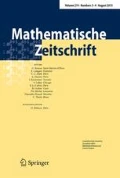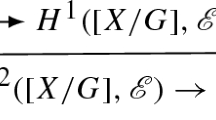Abstract
We prove several related results on the low-degree Hodge numbers of proper smooth rigid analytic varieties over non-archimedean fields. Our arguments rely on known structure theorems for the relevant Picard varieties, together with recent advances in p-adic Hodge theory. We also define a rigid analytic Albanese naturally associated with any smooth proper rigid space.
Similar content being viewed by others
Notes
Note that the perfectness assumption of the residue field here is not essential, as Hodge numbers doesn’t change under ground field extension.
Although the way to write this extension is non-canonical, this number \(r-k\) only depends on X
Here and elsewhere in this paper, we use \(\mathbb {C}_K \;{:=}\; \widehat{\overline{K}}\) to denote the completion of an algebraic closure of K.
In our situation where the ground field has characteristic 0, one can drop the smoothness in this definition.
The proof of the analogous result for abelian varieties given in loc. cit. extends with almost no change to the setting of abeloid varieties, except that one has to use the rigid geometry version of rigidity lemma (c.f. [16, Lemma 7.1.2]).
The authors would like to thank Professor Michael Temkin for pointing this reference to us in a private communication.
This Proposition was essentially proved by W. Cherry in [3] with the same proof (he only mentions abelian varieties instead of general abeloids, but the proof is identical in the abeloid case). We thank the referee for pointing this out to us.
Note that the concept of overconvergent is called conservative in loc. cit.
References
Alexander Grothendieck. Technique de descente et théorèmes d’existence en géométrie algébrique. VI. Les schémas de Picard: propriétés générales. In Séminaire Bourbaki, Vol. 7, pages Exp. No. 236, 221–243. Soc. Math. France, Paris, 1995
Berkovich, Vladimir G.: Spectral Theory and Analytic Geometry Over Non-Archimedean Fields. Mathematical Surveys and Monographs, vol. 33. American Mathematical Society, Providence (1990)
Cherry, William: Non-Archimedean analytic curves in abelian varieties. Math. Ann. 300(3), 393–404 (1994)
David Mumford. Abelian varieties, volume 5 of Tata Institute of Fundamental Research Studies in Mathematics. Published for the Tata Institute of Fundamental Research, Bombay; by Hindustan Book Agency, New Delhi, 2008. With appendices by C. P. Ramanujam and Yuri Manin, Corrected reprint of the second (1974) edition
de Jong, Johan, van der Put, Marius: étale cohomology of rigid analytic spaces. Doc. Math. 1(01), 1–56 (1996)
Evan Warner. Adic moduli spaces. PhD thesis, Stanford, https://searchworks.stanford.edu/view/12135003, 2017
Fresnel, Jean, van der Put, Marius: Rigid Analytic Geometry and Its Applications. Progress in Mathematics, vol. 218. Birkhäuser Boston Inc, Boston (2004)
Harm Voskuil. Non-Archimedean Hopf surfaces. Sém. Théor. Nombres Bordeaux (2), 3(2):405–466, 1991
Hartl, Urs, Lütkebohmert, Werner: On rigid-analytic Picard varieties. J. Reine Angew. Math. 528, 101–148 (2000)
Lütkebohmert, Werner: The structure of proper rigid groups. J. Reine Angew. Math. 468, 167–219 (1995)
Mustafin, G.A.: \(p\)-adic Hopf varieties. Funkcional. Anal. i Priložen. 11(3), 86–87 (1977)
Peter Scholze. \(p\)-adic Hodge theory for rigid-analytic varieties. Forum Math. Pi, 1:e1, 77, 2013
Schneider, Peter: Points of rigid analytic varieties. J. Reine Angew. Math. 434, 127–157 (1993)
Shizhang Li. On rigid varieties with projective reduction. J. Algebraic Geom. (2019). https://doi.org/10.1090/jag/740
Temkin, Michael: Functorial desingularization over q: boundaries and the embedded case. Israel J. Math. 224(1), 455–504 (2018)
Werner Lütkebohmert. Rigid geometry of curves and their Jacobians, volume 61 of Ergebnisse der Mathematik und ihrer Grenzgebiete. 3. Folge. A Series of Modern Surveys in Mathematics [Results in Mathematics and Related Areas. 3rd Series. A Series of Modern Surveys in Mathematics]. Springer, Cham, 2016
Wolf P. Barth, Klaus Hulek, Chris A. M. Peters, and Antonius Van de Ven. Compact complex surfaces, volume 4 of Ergebnisse der Mathematik und ihrer Grenzgebiete. 3. Folge. A Series of Modern Surveys in Mathematics [Results in Mathematics and Related Areas. 3rd Series. A Series of Modern Surveys in Mathematics]. Springer-Verlag, Berlin, second edition, 2004
Acknowledgements
The second named author would like to thank his advisor Professor Johan de Jong for many helpful discussions during the preparation of this paper. He would also like to thank Zijian Yao, Dingxin Zhang and Yang Zhou for discussing things related to this paper. We thank various anonymous referees heartily for providing many valuable comments and suggestions concerning previous drafts of this article.
Author information
Authors and Affiliations
Corresponding author
Additional information
Publisher's Note
Springer Nature remains neutral with regard to jurisdictional claims in published maps and institutional affiliations.
Rights and permissions
About this article
Cite this article
Hansen, D., Li, S. Line bundles on rigid varieties and Hodge symmetry. Math. Z. 296, 1777–1786 (2020). https://doi.org/10.1007/s00209-020-02535-3
Received:
Accepted:
Published:
Issue Date:
DOI: https://doi.org/10.1007/s00209-020-02535-3



